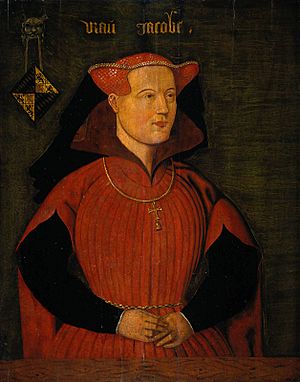Humphrey, Duke of Gloucester facts for kids
Quick facts for kids Humphrey of Lancaster |
|
|---|---|
| Duke of Gloucester | |
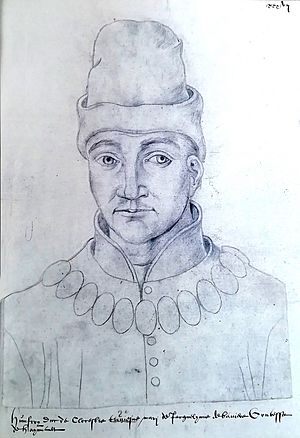
c. 16th-century drawing based on contemporary portrait (from the Recueil d'Arras)
|
|
| Born | 3 October 1390 |
| Died | 23 February 1447 (aged 56) Bury St Edmunds, Suffolk |
| Burial | 4 March 1447 St Albans Abbey |
| Spouse | Jacqueline of Hainaut (m. 1422, ann. 1428) Eleanor Cobham (m. 1428–1431, ann. c. 1441) |
| Issue | Arthur of Gloucester (illegitimate); Antigone, Countess of Tankerville (illegitimate) |
| House | Lancaster |
| Father | Henry IV of England |
| Mother | Mary de Bohun |
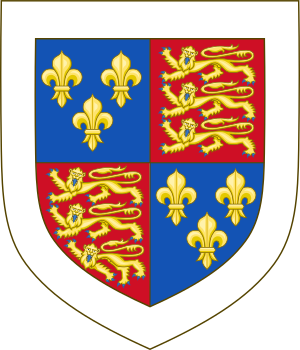
Humphrey of Lancaster, Duke of Gloucester was an English prince, soldier, and a big supporter of learning. He was born on October 3, 1390, and died on February 23, 1447. He was the youngest son of King Henry IV of England, brother of King Henry V, and uncle of King Henry VI. Humphrey fought in the Hundred Years' War. He also helped rule England when his nephew, Henry VI, was too young to be king.
People had mixed feelings about him. Some thought he was a bit wild and hard to get along with. But he was also known for being very smart. He was one of the first important English supporters of humanism, a new way of thinking during the Renaissance.
Unlike his older brothers, Humphrey did not lead many armies for his father. Instead, he spent a lot of time studying and learning. He was made Duke of Gloucester in 1414. He joined his brother Henry V in battles in France during the Hundred Years' War. He fought bravely at the Battle of Agincourt in 1415. He also helped conquer Normandy between 1417 and 1419.
After King Henry V died in 1422, Humphrey became a key leader in the government. This government ruled while the new king, Henry VI, was still a baby. Humphrey was sometimes seen as impulsive and difficult. He often argued with his brother, John, Duke of Bedford, and his uncle, Henry Beaufort. He even had a big fight with the Duke of Burgundy, who was an important ally for England in France. This fight was over land claims in the Low Countries.
Humphrey wanted more power in England but never fully got it. His attempts to gain his own foreign lands also failed. He strongly believed England should keep fighting in France and not give up any land. But as England faced more defeats, he lost favor with the government and King Henry VI.
In 1441, his second wife, Eleanor Cobham, was accused of witchcraft. This event greatly reduced Humphrey's political power. In 1447, he was accused of treason, which was probably a false charge. He died a few days later while he was under arrest.
Despite some problems in his public and private life, Humphrey was often praised. He was a great supporter of learning and helped the University of Oxford. People who wrote books and poems liked him because he was so interested in studies. Ordinary people liked him because he wanted England to be strong in its foreign policy. Because of this, he was known as the "good Duke Humphrey."
Contents
Humphrey's Early Life and Military Role
We don't know exactly where Humphrey was born. He was named after his grandfather, Humphrey de Bohun, 7th Earl of Hereford. He was the youngest of four brothers who were very close. On March 20, 1413, Humphrey and his brother Henry were with their father, King Henry IV, as he was dying.
All four brothers, Thomas, John, and Humphrey, became knights in 1399. They also joined the Order of the Garter together in 1400.
During his father's rule, Humphrey received a good education. His older brothers were busy fighting battles in Wales and Scotland. After his father died, Humphrey was made Duke of Gloucester in 1414. He also became the Chamberlain of England and took his place in Parliament. In 1415, he joined the Privy Council, a group of advisors to the king.
Before the army went to France, they camped in Southampton. There, the Earl of Cambridge tried to assassinate the king. Humphrey and his brother, the Duke of Clarence, led an investigation. They found Cambridge and Scrope guilty of treason on August 5.
Humphrey's Successes in France
Humphrey became known as a successful commander during King Henry V's campaigns in France. He used his knowledge of ancient warfare to help capture Honfleur. During the Battle of Agincourt, Humphrey was wounded. As he fell, the king protected him from French knights.
For his brave service, Humphrey received important positions. He became Constable of Dover and Warden of the Cinque Ports. He was also named the King's Lieutenant. His time in government was peaceful and successful.
An important visitor during this time was Emperor Sigismund from the Holy Roman Empire. He came to England on a peace mission. Humphrey welcomed the Emperor on the shore with a sword in his hand. He made sure Sigismund understood that the English king was independent before allowing him to land. This happened on May 1, 1416.
A treaty of "eternal friendship" was signed at Canterbury on August 15. But this treaty only hinted at more fighting to come with France.
Humphrey as Lord Protector
When his brother, King Henry V, died in 1422, Humphrey became Lord Protector for his young nephew, Henry VI. This meant he helped rule England because the king was too young. After his older brother, John, Duke of Bedford, died in 1435, Humphrey also claimed the right to be the main ruler of England.
However, the lords on the king's council did not fully agree with Humphrey's claims. His half-uncle, Cardinal Henry Beaufort, especially disagreed. Later, in 1978, King Henry V's will was found at Eton College. It actually supported Humphrey's claims to power.
In 1436, Philip, the Duke of Burgundy, attacked Calais. Duke Humphrey was put in charge of defending the city. The attackers came from land, but the English fought back strongly. Humphrey then led his army to Baillieul to safety. He even threatened St. Omer before sailing back home.
Humphrey was always popular with the people of London and the common folk. He was also widely known for supporting learning and the arts. His popularity and ability to keep peace earned him the job of Chief Justice of South Wales.
However, his marriage to Eleanor Cobham became a problem for his enemies. Eleanor was arrested and tried for sorcery and heresy in 1441. After this, Humphrey stepped away from public life. He himself was arrested on February 20, 1447, accused of treason. He died three days later in Bury St Edmunds, Suffolk. He was buried at St Albans Abbey, next to St Alban's shrine. At the time, some people thought he had been poisoned. But it is more likely he died from a stroke.
Humphrey's Marriages and Children

Humphrey married twice but did not have any children who could legally inherit his titles.
First Marriage: Jacqueline, Countess of Hainaut and Holland
Around 1423, Humphrey married Jacqueline, Countess of Hainaut and Holland. She was the daughter of William VI, Count of Hainaut. Through this marriage, Humphrey became the "Count of Holland, Zeeland and Hainault." He briefly fought to keep these titles when Jacqueline's cousin, Philip the Good, challenged them. This conflict was part of the War of Succession in Holland.
Humphrey and Jacqueline had a baby who was stillborn in 1424. Their marriage was ended in 1428. Jacqueline died in 1436, having lost her right to her lands.
Second Marriage: Eleanor Cobham
In 1428, Humphrey married Eleanor Cobham. She had been his mistress before they married. In 1441, Eleanor was tried and found guilty of practicing witchcraft against the king. This was supposedly an attempt to help her husband keep his power. She was punished with public shame, then sent away and imprisoned for life. Humphrey and Eleanor did not have any children together.
Humphrey's Children
Humphrey had two children with women who were not his wives. It is possible that Eleanor Cobham was the mother of one or both of them before she married Humphrey. Because these children were born outside of marriage, they could not inherit their father's titles.
His illegitimate children were:
- Arthur Plantagenet (died after 1447)
- Antigone Plantagenet, who first married Henry Grey, 2nd Earl of Tankerville, Lord of Powys (around 1419–1450). She later married John d'Amancier.
Humphrey's Legacy and Influence
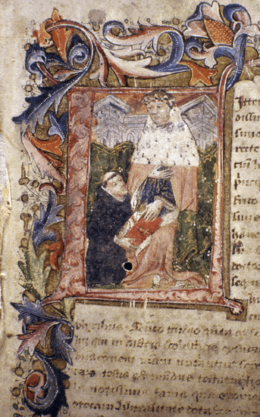
After inheriting the manor of Greenwich, Humphrey created Greenwich Park. From 1428, he built a palace there called Bella Court, which later became the Palace of Placentia. The Duke Humphrey Tower, which stood on Greenwich Park, was taken down in the 1660s. The site was then chosen for building the Royal Observatory.
Humphrey's name lives on in Duke Humfrey's Library, which is part of the Bodleian Library at Oxford University. There is also Duke Humphrey Road on Blackheath, south of Greenwich. Duke Humphrey was a great supporter of Oxford University. He gave more than 280 handwritten books to the university. Having such a large library helped encourage new learning.
Duke Humphrey also supported writers, especially the poet John Lydgate and John Capgrave. He wrote letters to many important Italian humanists. He also paid for Greek classic books to be translated into Latin. His friendship with Zano Castiglione, Bishop of Bayeux, led to many more connections in Europe. These included Leonardo Bruni, Pietro Candido Decembrio, and Tito Livio Frulovisi. Duke Humphrey also supported the Abbey of St Albans.
Duke Humphrey's Walk was the name of an area in Old St Paul's Cathedral. People thought it was near Duke Humphrey's tomb. However, it was actually a monument to John Lord Beauchamp de Warwick (died 1360). This area was often visited by thieves and beggars. The saying "to dine with Duke Humphrey" meant that poor people had no money for a meal. The writer Saki updated this phrase by calling a picnic without food a "Duke Humphrey picnic."
In reality, Humphrey's tomb is in the Abbey of St Albans (the cathedral). It was restored by Hertfordshire Freemasons in 2000 to celebrate the new millennium.
Humphrey in Literature

In Shakespeare's history plays, Humphrey is shown in a very positive way. In the plays about the War of the Roses, he is one of the few historical figures shown only in a good light. He appears as a small character in Henry IV, Part 2 and Henry V. But he is a major character in two other plays. His arguments with Cardinal Beaufort are shown in Henry VI, Part 1. His downfall and death after his wife was accused of sorcery are in Henry VI, Part 2. Shakespeare shows Humphrey's death as a murder. He says it was ordered by William de la Pole, 1st Duke of Suffolk, and Queen Margaret of Anjou.
The 1723 play Humphrey, Duke of Gloucester by Ambrose Philips is about Humphrey's life. In the first show at the Drury Lane theater, Barton Booth played Humphrey.
Margaret Frazer's 2003 historical mystery novel, The Bastard's Tale, is about the events around Humphrey's arrest and death.
Titles and Honors
- Duke of Gloucester; created in 1414 (second creation).
- Earl of Pembroke; created in 1414 (fifth creation). This title was later meant to be passed down in families. But it went to William de la Pole instead.
- Lord Warden of the Cinque Ports, 1415.
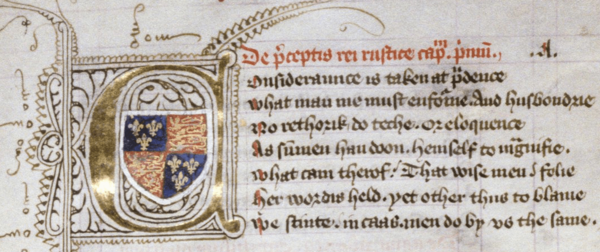
Images for kids
See also
 In Spanish: Hunfredo de Gloucester para niños
In Spanish: Hunfredo de Gloucester para niños



